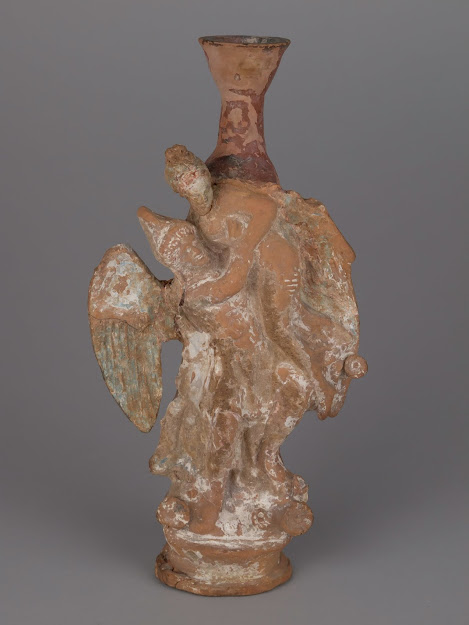A lekythos, usually a narrow-bodied ceramic or stone vessel with one handle and no pouring lip, was used to store and dispense oil. Examples have been found dating as far back as 700 BCE. Although lekythoi were used to apply perfumed oil to the skin of a woman about to be married, they were most commonly used to anoint the bodies of the dead. Some scholars think their presence in tombs of unmarried women was to allow them to prepare for a wedding in the afterlife.
The images on lekythoi were often depictions of daily activities, mythological scenes, or rituals. Because they were most often used in a funerary context, many depicted funerary rites or a scene of loss or departure. Some 5th century examples feature paintings on a white ground. Spanning barely a century, the “white-ground” style developed in Athens alongside the red figure technique. Although they appear to be minimally detailed outline drawings that some scholars think are due to the funerary nature of the scenes depicted, curators at the Walters Art Museum point to the delicate nature of the white ground technique that often results in the thin color applications flaking away leaving only the artists' outlines. Some lekythoi were fitted with a small, inner chamber so that they might appear full, while in reality they contained only a small amount of expensive oil.
 |
| Lekythos depicting Boreas, the North Wind, carrying off Oreithyia courtesy of the Metropolitan Museum of Art |
 |
| Figural lekythos in the form of a white ground sphinx 350-325 BCE from Athens courtesy of the Boston Museum of Fine Art |
 |
| Terracotta lekythoi with white ground Greek made in Athens about 460 BCE that I photographed at the Getty Villa in Pacific Palisades, California |
 |
White ground lekythos depicting
Hypnos and Thanatos carrying the body of Sarpedon from the battlefield of Troy by the Thanatos painter at the British Museum. Courtesy of Wikimedia Commons. |
 |
| Lekythos (Squat type) The youth Chrysippos with Aphrodite, Eros, and Pompe: Chrysippos, wearing the boots, mantle, and broad-brimmed hat of a traveler, talks with Eros who points toward Aphrodite. Next to the goddess stands a casket, on it a pair of shoes. The woman to the left is unidentified, the other one is Pompe (the personification of procession). Beside her are traces of a ritual basket that would have been depicted in applied clay with gilding. The details of the scene point to a marriage procession, 410 BCE courtesy of the Metropolitan Museum of Art. |
 |
| Lekythos depicting a white-ground sphinx 380-360 BCE courtesy of the Metropolitan Museum of Art |
 |
| Unusual terracotta lekythos from south Italy, Apulian, 4th century BCE courtesy of the Metropolitan Museum of Art. |
 |
| Unusual figural lekythos in the form of Aphrodite rising from an open shell, with two Erotes hovering above, from the first half of the 4th century BCE excavated at Eretria, Greece. Image courtesy of the Boston Museum of Fine Arts. |


 |
| Unusually large terracotta lekythos attributed to the Eretria Painter ca. 420 BCE subdivided into three zones, each with a mythological subject. The middle zone features Thetis and her sister Nereids bringing armor to replace the set that Achilles had given Patroklos. The lower zone depicts Theseus and Hippolyte in combat among Greeks and Amazons. In both cases, the subject concerns a woman in martial mode and a warrior. The uppermost scene has been interpreted as the abduction of Persephone but more likely shows a god (or goddess) departing on a mission of divine intervention. The placement of the white-ground zone between two in red-figure emphasizes the Eretria Painter's extraordinary draftsmanship. It may also indicate the funerary purpose of the vase. Courtesy of the Metropolitan Museum of Art |
 |
| White-ground lekythos depicting a young man arming himself Greek made in Athens by Douris about 490 BCE Terracotta that I photographed at the Getty Villa. |
















Comments
Post a Comment